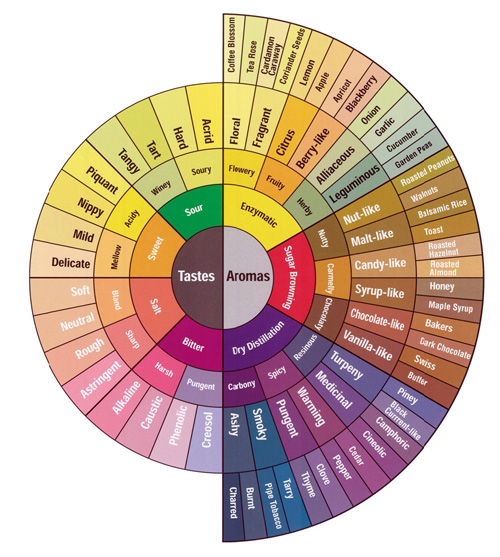Glossary of terms for coffee tasting-Coffee Tasting Terms Starbucks coffee tasting theme

Professional coffee knowledge exchange more coffee bean information please follow the coffee workshop (Wechat official account cafe_style)
Consciously tasting coffee: the correct use and tips for the flavor wheel of SCAA coffee
When you taste coffee, you must try to distinguish the comfortable and pleasant taste, consistency, acidity and aroma of coffee. Below are the criteria by which most cup testers are accustomed to judging coffee:
Acidity acidity
Acidity is a typical and anticipated part of coffee. It is a direct taste sensation that occurs under the edge of your tongue and on your upper jaw. it plays a different role from taste to wine. Acidity provides a strong, distinct and active texture. Without acidity, coffee will tend to be dull and monotonous. Pay attention to this acidity and do not confuse it with fermented acidity and uncomfortable negative flavor features.
Aroma aroma
The aroma is more difficult to separate from the so-called taste! Without the sense of smell, we can only feel the sour, sweet, astringent and bitter taste of coffee; the aroma derived from brewing coffee can be combined with our upper jaws to distinguish subtle differences such as "flower aroma" and "wine". To form the so-called taste.
Body strength and consistency
Intensity is a feeling, a feeling of coffee in your mouth! It is a combination of viscosity, weight, or hierarchy that can be detected by the tongue. The ideal range of coffee consistency is like the comparative difference between complete milk and water. The strength of the coffee we feel depends on whether the oil can be completely extracted and dissolved in the brewing process. In principle, coffee from Indonesia has a thicker body than coffee from Central and South America. If you can't compare different coffees, try to add the same amount of dairy products to each other. The thicker coffee can still maintain a higher proportion of flavor after the dairy products are diluted.
Flavor taste
The overall feeling of coffee in your mouth is called taste. Acidity, aroma and consistency are the conditions that make up the so-called taste. These taste feelings, probably in a balanced time, can create the overall taste and charm!
The following are typical taste characteristics:
General taste characteristics
Full-bodied
It's about consistency and plumpness.
Complicated
The feeling of a variety of flavors
Equilibrium
All the basic flavor characteristics, none of them stand out but have a complete performance.
Ideal popular taste, its typical and specific characteristics (description)
● bright, refreshing, conspicuous or lively and beautiful
[special flavor of Central American coffee, etc.]
● caramel color
Like honey or candy.
● Chocolate
The aftertaste is similar to unsweetened chocolate or vanilla
● is light and delicious
A faint taste appears on the tip of the tongue [typical flavor of Arabica, New Guinea]
● earthy taste
The characteristics of the soil [the special flavor of Sumatran coffee]
● fragrance
The range of aroma characteristics from natural flower fragrance to spice addition
● fruit flavor
An aroma characteristic associated with berries, dried fruits, or oranges.
● glycol
The smooth taste in the mouth basically requires some acid.
● nutty flavor
The aftertaste is similar to that of a roasted drupe.
● spice
Reminiscent of the taste and aroma of spices
● is sweet
A non-astringent free taste
● is wild.
A game that is not often thought of and accepted, but it is [the characteristics of Ethiopian coffee]
● wine flavor
The aftertaste is reminiscent of fine wine [typical of Kenyan and Yemeni coffee]
Undesirable and unpopular taste, its typical and specific characteristics (description)
● bitter taste
It is usually caused by excessive baking and can be detected and felt at the base of the tongue.
● is insipid.
A neutral, vague taste.
● carbon flavor
Generally speaking, it is like burnt charcoal.
● Dead (dead, boring)
As described as "monotonous and tasteless" below
● opacity
Such as eating filth and thinking of moldy things.
● earthy taste
As described as "muddy" above
● is monotonous and stale.
Lack of acidity, aroma and aftertaste
● grass flavor
From aroma and taste to freshly mowed lawn
● is pungent.
Having a clumsy characteristic of corrosion or fishy smell.
● turbidity
Thick and muddy
Musty smell of ●
It smells slightly suffocating and stale.
[the above negative words are different from the taste of old coffee beans]
● water taste
It's kind of similar to the structure of starch and water after noodles are cooked.
● astringent taste
Like the feeling of the tongue when eating salt
● rubber flavor
The aroma and taste are similar to burnt rubber
[found to be only the characteristics of the dried Romda species]
● is weak
As described above as "insipid"
● is inferior to sour taste
The sharp sour taste is like unripe fruit
● is thin
Lack of acidity is in principle caused by incomplete fermentation
● turpentine flavor
Smells like turpentine.
● is poor
Lack of strength and consistency in the mouth
● game
Have the characteristics of primitive game
.
.
Important Notice :
前街咖啡 FrontStreet Coffee has moved to new addredd:
FrontStreet Coffee Address: 315,Donghua East Road,GuangZhou
Tel:020 38364473
- Prev

Why coffee tasting cup testing coffee tasting classroom evaluation form how to fill in
Professional coffee knowledge exchange more coffee bean information please follow the coffee workshop (Wechat official account cafe_style) consciously taste coffee: the correct use of SCAA coffee flavor wheel and the use of tips coffee taste cup test Cupping or Cup Testing taste cup test (Cupping or Cup Testing)! I believe that people who love coffee will have heard of it.
- Next

Can I have coffee on an empty stomach? Professional answer to the pros and cons of drinking coffee on an empty stomach
Professional coffee knowledge exchange more coffee bean information please pay attention to the coffee workshop (Wechat official account cafe_style) the role and effect of coffee, applicable scope can I drink coffee on an empty stomach in the morning? Now many young people have formed the habit of drinking coffee in the morning, so how about drinking coffee on an empty stomach in the morning? It is reported that you can't drink coffee without an empty stomach in the morning, but on the contrary, in the morning.
Related
- How did the Salvadoran coffee industry develop in Central America?
- What exactly does the golden cup extraction of coffee mean?
- The Origin of Coffee flower
- [2023 Starbucks World Earth Day] there are more meaningful things besides free Starbucks coffee!
- What kind of coffee is there in Spain? 9 Flavors of Spanish Coffee
- Aromatic African coffee| Kenya's coffee culture and historical production area
- Liberica Coffee Bean knowledge: the characteristics of Liberian Coffee beans of the three original species of Coffee beans
- The origin and formula of Spanish latte introduces the taste characteristics of Bombon coffee in Valencia, Spain.
- How to adjust the solution of over-extracted coffee
- What is the tasting period of coffee beans? What is the period of coffee and beans? How should coffee wake up and raise beans?

